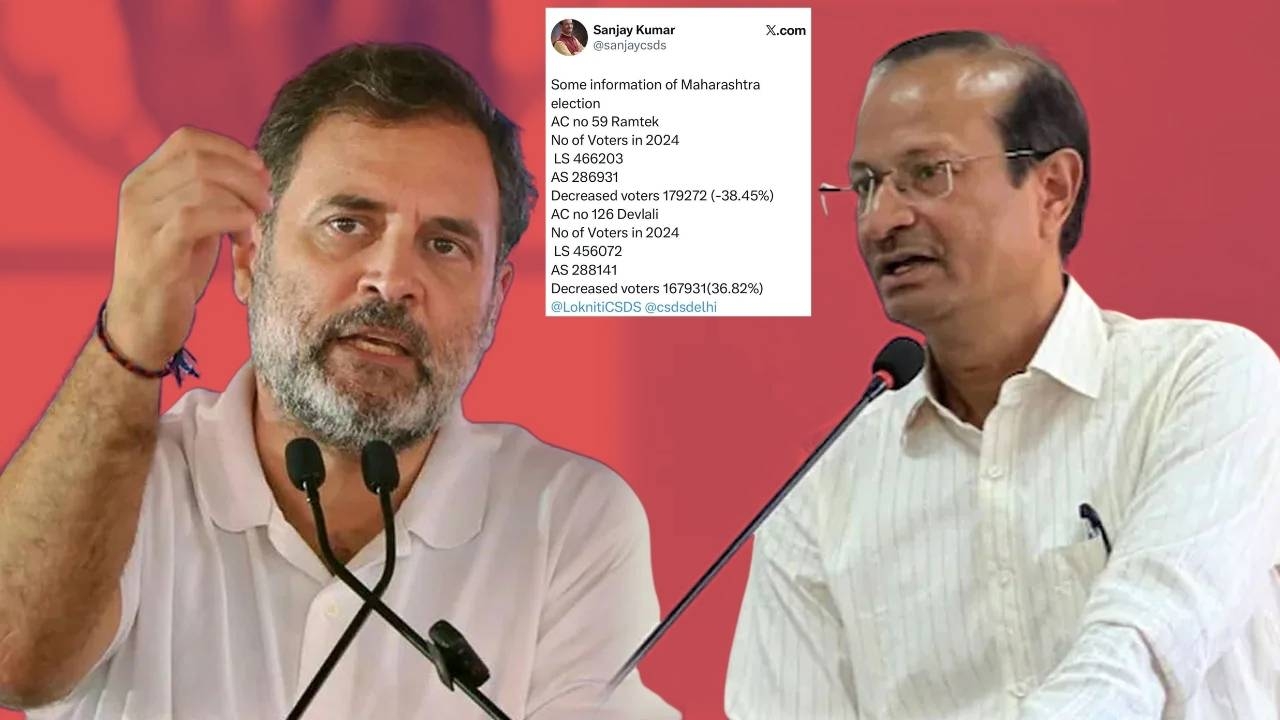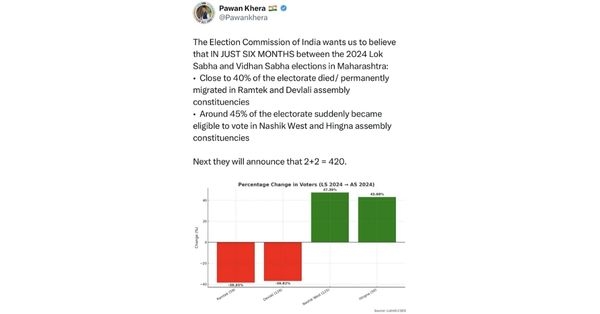Did Sanjay Kumar’s tweet, ‘Vote Chori,’ expose the biggest political lie of Congress?
The ‘Vote Chori’ narrative Congress pushed with paid influencers fell apart when Sanjay Kumar admitted his numbers on Maharashtra were wrong.
Total Views |

Rahul Gandhi’s largest PR stunt of ‘Vote Chori’, with the crores of rupees flowing to social media influencers and paid journalists of YouTube to hijack social media’s algorithm with flashing reels of Rahul Gandhi surfacing the claim of ‘Vote Chori’, aiming to question Indian voters’ sovereignty and right to vote, gets busted, with Sanjay Kumar issuing a sorry tweet over producing fake data on Maharashtra’s elections.
What Happened?
On 18th August, Congress spokesperson Pawan Khera posted a graphic on X to question the Election Commission of India. In his post, he claimed that within six months between the 2024 Lok Sabha and the Maharashtra Assembly polls, around 40% of the electorate were deleted from the Ramtek and Deolali constituencies. On the other hand, Nashik West and Hingna gained around 45% of the electorate. Taking a jibe at the Election Commission, he wrote, “Next they will announce that 2 plus 2 equals 420.” The source of the data was Lokniti-CSDS.

Notably, his post was based on the figures first pushed by Sanjay Kumar of the Centre for the Study of Developing Societies (CSDS), who, on 17th August, posted the figures raising doubts on the working of the Election Commission of India. However, within 48 hours, the claims by both Sanjay Kumar and Congress leaders who shared the data collapsed like a house of cards.
What did CSDS’s Sanjay Kumar claim?
In his now-deleted post on social media platform X, Kumar spotlighted two seats as examples of abnormal surges. He claimed that for Nashik West, the Lok Sabha roll was 328,053 and the Assembly roll was 483,459, which he presented as an increase of 155,442 and 47.38 per cent.
Similarly, for Hingna, he claimed that the Lok Sabha roll was 314,605 and the Assembly roll was 450,414, an increase he put at 135,536 and 43.08 per cent.
The framing of the post suggested that the Assembly electorate had swelled beyond plausible bounds within a few months. His figures were then amplified not only by Congress and other opposition party supporters.
What’s the real case? What does the data show?
In Nashik West, Lok Sabha electorate numbers were at 456,319 compared to the number of electorates in Maharashtra Assembly elections, which was at 483,719. The increase is 27,400, which is about six per cent. There is no jump of 1.5 lakh as claimed by Sanjay.
Similarly, in Hingna for Lok Sabha, the number stood at 424,454, and for Assembly elections, the number stood at 450,439. The increase is 25,298, which is far below the 43.08 per cent claimed in the viral post.
In the case of Ramtek, for the Lok Sabha, the number of the electorate was 276,827 compared to the Assembly elections, which stood at 287,301. The increase is 10,474, which is about 3.8 per cent. The chart Khera shared showed a collapse of nearly forty per cent. The official record shows a small rise.
Similarly, in the case of Deolali, for Lok Sabha, the numbers stood at 277,600, and for Assembly elections, it was 288,816. The increase is 11,216. The claim of a massive fall is false.
And this suggests that the sensational percentages that travelled through politics and media were not drawn from constituency abstracts. They came from a spreadsheet that was “misread” by the “data team” of CSDS. A simple double check would have stopped the error at source.
BJP on the CSDS’s data manipulation
The controversy around Sanjay Kumar’s misleading voter roll claims prompted a sharp counter from the Bharatiya Janata Party (BJP). Its IT Cell chief, Amit Malviya, accused the CSDS of being more than just a research institution and accused it of playing a dangerous game of narrative-building for years.
Malviya pointed to repeated infusions of foreign funds into CSDS from organisations including the Ford Foundation, IDRC Canada, DFID UK, NORAD Norway, the Hewlett Foundation and others. He suggested that these donors are not neutral but carry political agendas. According to Malviya, their interests lie in weakening India’s social fabric by nurturing division, especially within Hindu society.
He argued that the Lokniti-CSDS programme has consistently projected Hindu society through the prism of caste. On the other hand, Muslims have been presented as a monolithic bloc. CSDS has carefully avoided their own internal stratifications, such as Ashraf, Ajlaf, Arzal, and others. The result, he said, is an artificial reinforcement of caste division among Hindus, giving Congress and sympathetic media convenient points every election cycle.
He also pointed out that CSDS surveys lack scientific rigour, with caste identities often guessed rather than systematically recorded, and yet newspapers of record like The Hindu and The Indian Express give their findings legitimacy. The institution, in his words, is not producing scholarship but playing strategy, manufacturing divisions and presenting them as research.
In his framing, CSDS’s errors are not innocent mistakes like “rows misread” but deliberate agenda-driven settings gone awry. He further asserted that these agendas are designed to reinforce narratives favourable to the Congress while undermining public faith in institutions like the Election Commission.
Article by

Kewali Kabir Jain
Journalism Student at Makhanlal Chaturvedi National University of Journalism and Communication

